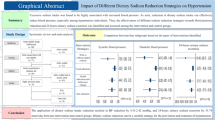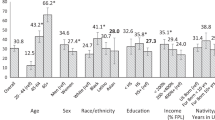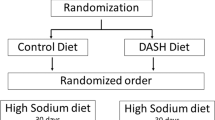Abstract
Sodium reduction is efficacious for primary prevention of hypertension, but the feasibility of achieving this effect is unclear. The objective of the paper is detailed analyses of adherence to and effects of the sodium reduction intervention among overweight adults in the Trials of Hypertension Prevention, Phase II. Sodium reduction (comprehensive education and counselling about how to reduce sodium intake) was tested vs no dietary intervention (usual care) for 36–48 months. A total of 956 white and 203 black adults, ages 30–54 years, with diastolic blood pressure 83–89 mmHg, systolic blood pressure (SBP) <140 mmHg, and body weight 110–165% of gender-specific standard weight were included in the study. At 36 months, urinary sodium excretion was 40.4 mmol/24 h (24.4%) lower in sodium reduction compared to usual care participants (P<0.0001), but only 21% of sodium reduction participants achieved the targeted level of sodium excretion below 80 mmol/24 h. Adherence was positively related to attendance at face-to-face contacts. Net decreases in SBP at 6, 18, and 36 months of 2.9 (P<0.001), 2.0 (P<0.001), and 1.3 (P=0.02) mmHg in sodium reduction vs usual care were associated with an overall 18% lower incidence of hypertension (P=0.048); were relatively unchanged by adjustment for ethnicity, gender, age, and baseline blood pressure, BMI, and sodium excretion; and were observed in both black and white men and women. From these beneficial but modest results with highly motivated and extensively counselled individuals, sodium reduction sufficient to favourably influence the population blood pressure distribution will be difficult to achieve without food supply changes.
This is a preview of subscription content, access via your institution
Access options
Subscribe to this journal
Receive 12 digital issues and online access to articles
$119.00 per year
only $9.92 per issue
Buy this article
- Purchase on Springer Link
- Instant access to full article PDF
Prices may be subject to local taxes which are calculated during checkout



Similar content being viewed by others
References
National High Blood Pressure Education Program. The Sixth Report of the Joint National Committee on the prevention, detection, evaluation, and treatment of high blood pressure. Arch Intern Med 1997; 157: 2413–2446.
Midgley JP, Matthew AG, Greenwood CMT, Logan AG . Effect of reduced dietary sodium on blood pressure: a meta-analysis of randomized controlled trials. JAMA 1996; 275: 1590–1597.
Cutler JA, Follmann D, Allender PS . Randomized trials of sodium reduction: an overview. Am J Clin Nutr 1997; 65(Suppl): 643S–651S.
Graudal N, Galloe A, Garred P . Effects of sodium restriction on blood pressure, renin, aldosterone, catecholamines, cholesterols, and triglyceride: a meta-analysis. JAMA 1998; 279: 1383–1391.
Hooper L, Bartlett C, Davey Smith G, Ebrahim S . Systematic review of long term effects of advice to reduce dietary salt in adults. BMJ, (bmj.com) 2002; 325(1–9): 628.
Committee on Diet and Health, Food and Nutrition Board, Commission on Life Sciences, National Research Council. Diet and Health: Implications for Reducing Chronic Disease Risk. National Academy Press: Washington, DC, 1989.
Working Group on Primary Prevention of Hypertension. National High Blood Pressure Education Program Working Group Report on primary prevention of hypertension. Arch Intern Med 1993; 153: 186–208.
Nutrition and Your Health: Dietary Guidelines for Americans. Fifth edn. Home and Garden Bulletin No. 232. U.S. Departments of Agriculture and Health and Human Services: Washington, DC, 2000.
Trials of Hypertension Prevention Collaborative Research Group. The effects of nonpharmacological interventions on blood pressure of persons with high normal levels: results of the Trials for Hypertension Prevention, Phase 1. JAMA 1992; 267: 1213–1220.
Kumanyika SK, et al, for the Trials of Hypertension Collaborative Research Group. Feasibility and efficacy of sodium reduction in the trials of hypertension prevention, Phase I. Hypertension 1993; 22: 502–512.
Trials of Hypertension Prevention Collaborative Research Group. Effects of weight loss and sodium reduction intervention on blood pressure and hypertension incidence in overweight persons with high-normal blood pressure. The Trials of Hypertension Prevention phase II. Arch Intern Med 1997; 157: 657–667.
Hebert PR, et al, for the Trials of Hypertension Prevention (TOHP) Collaborative Research Group. Design of a multicenter trial to evaluate long-term lifestyle intervention in adults with high-normal blood pressure levels. Trials of Hypertension Prevention (Phase II). Ann Epidemiol 1995; 5: 130–139.
Cook NR, Kumanyika SK, Cutler JA, Whelton PK, for the Trials of Hypertension Prevention Collaborative Research Group. Dose–response of sodium reduction and blood pressure change in overweight, non-hypertensive adults in a three-year dietary intervention study. J Human Hypertens (in press).
1983 Metropolitan height and weight tables. Stat Bull Metrop Life Insur Co 1984; 64: 2–9.
Lasser VI et al. Trials of hypertension prevention, phase II: structure and content of the weight loss and dietary sodium reduction interventions. Ann Epidemiol 1995; 5: 156–164.
Hunt SC et al. Angiotensinogen genotype, sodium reduction, weight loss, and prevention of hypertension: trials of hypertension prevention, phase II. Hypertension 1998; 32: 393–401.
Svetky LP et al. Angiotensinogen genotype and blood pressure response in the Dietary Approaches to Stop Hypertension (DASH) Study. J Hypertens 2001; 19: 1949–1956.
Appel LJ et al. Baseline characteristics of participants in phase II of the Trials of Hypertension Prevention (TOHP II). Trials of Hypertension Prevention (TOHP) Collaborative Research Group. Ann Epidemiol 1995; 5: 149–155.
Griffith LE et al. The influence of dietary and nondietary calcium supplementation: an updated meta-analysis of randomized controlled trials. Am J Hypertens 1999; 12(Part 1): 84–92.
Stamler J et al. Relationship to blood pressure of combinations of dietary macronutrients: findings of the Multiple Risk Factor Intervention Trial (MRFIT). Circulation 1996; 94: 2417–2423.
Cleveland LE, Escobar AJ, Lutz SM, Welsh SO . Method for identifying differences between existing food patterns and patterns that meet dietary recommendations. J Am Diet Assoc 1993; 93: 556–563.
Mattes RD, Donnelly D . Relative contributions of dietary sodium sources. J Am Coll Nutr 1991; 10: 383–393.
Evans M et al. Implementing Recommendations for Dietary Salt Reduction. Where Are We? Where Are We Going? How Do We Get There?, NIH Publication No. 55-728N. National Heart, Lung, and Blood Institute, National Institutes of Health, Bethesda, MD, 1996.
Wylie Rosett J et al. Trial of antihypertensive interventions and management. Greater efficacy with weight reduction than with a sodium-potassium intervention. J Am Diet Assoc 1993; 93: 408–415.
Wassertheil-Smoller S et al. Effective dietary intervention in hypertensives: sodium restriction and weight reduction. J Am Diet Assoc 1985; 85: 423–430.
Appel LJ et al. Effects of reduced sodium intake on hypertension control in older individuals. Arch Intern Med 2001; 161: 685–693.
Cook NR . An imputation method for non-ignorable missing data in studies of blood pressure. Stat Med 1997; 16: 2713–2728.
Law MR, Frost CD, Wald III NJ . Analysis of data from trials of salt reduction. BMJ 1991; 302: 819–824.
Stamler J, Stamler R, Neaton JD . Blood pressure, systolic and diastolic, and cardiovascular risks: US population data. Arch Intern Med 1993; 153: 598–615.
SHEP Cooperative Research Group. Prevention of stroke by antihypertensive drug treatment in older persons with isolated systolic hypertension. Final results of the Systolic Hypertension in the Elderly Program. JAMA 1991; 265: 3255–3264.
Staessen JA et al. Randomized double-blind comparison of placebo and active treatment for older patients with isolated systolic hypertension. The Systolic Hypertension in Europe (SYST-EUR) Trial Invesgigators. Lancet 1997; 350: 757–764.
Izzo JL, Levy D, Black HR . Importance of systolic blood pressure in older Americans. Hypertension 2000; 35: 1021–1024.
Sacks FM et al. Effects on blood pressure of reduced dietary sodium and the Dietary Approaches to Stop Hypertension (DASH) diet. DASH-Sodium Collaborative Research Group. N Engl J Med 2001; 344: 3–10.
Elmer PJ, Grimm RH, Laing B . Dietary sodium reduction for hypertension prevention and treatment. Hypertension 1991; 17(Suppl I): I-182–I-189.
Staessen JA, Liunen P, Thijs L, Fagard R . Salt and blood pressure in community-based intervention trials. Am J Clin Nutr 1997; 65(Suppl): 661S–670S.
Whelton P, et al, for the TONE Collaborative Research Group. Sodium reduction and weight loss in the treatment of hypertension in older persons: a randomized, controlled trial of nonpharmacologic interventions in the elderly (TONE). JAMA 1998; 279: 839–846.
Havas S, Roccella EJ, Lenfant C . Reducing the public health burden from elevated blood pressure levels in the United States by lowering intake of dietary sodium. Am J Public Health 2004; 94(1): 19–22.
He FJ, MacGregor GA . How far should salt intake be reduced? Hypertension 2003; 42: 1093–1099.
Tuomilehto J et al. Urinary sodium excretion and cardiovascular mortality in Finland: a prospective study. Lancet 2001; 357: 848–851.
He J et al. Dietary sodium intake and subsequent risk of cardiovascular disease in overweight adults. JAMA 1999; 282: 2027–2034.
Panel on Dietary Reference Intakes for Electrolytes and Water, Standing Committee on the Scientific Evaluation of Dietary Reference Intakes, Food and Nutrition Board, Institute of Medicine. Dietary Reference Intakes for Water, Potassium, Sodium, Chloride, and Sulfate. National Academy Press: Washington, DC, available at www.nap.edu, 2004.
Acknowledgements
Phase II of the Trials of Hypertension Prevention was supported by cooperative agreements HL 37852, HL 37924, HL 37907, HL 37904, HL 37854, HL 37849, HL 37884, HL 37853, HL 37899, and HL 37906 from the National, Heart, Lung, and Blood Institute, National Institutes of Health, Bethesda, MD. We express our appreciation to Marilyn Chown and Rose Ungarelli at the TOHP II Coordinating Center for their assistance with statistical programming.
Author information
Authors and Affiliations
Consortia
Corresponding author
Rights and permissions
About this article
Cite this article
Kumanyika, S., Cook, N., Cutler, J. et al. Sodium reduction for hypertension prevention in overweight adults: further results from the Trials of Hypertension Prevention Phase II. J Hum Hypertens 19, 33–45 (2005). https://doi.org/10.1038/sj.jhh.1001774
Received:
Revised:
Accepted:
Published:
Issue Date:
DOI: https://doi.org/10.1038/sj.jhh.1001774
Keywords
This article is cited by
-
Sodium Intake and Risk of Hypertension: A Systematic Review and Dose–Response Meta-analysis of Observational Cohort Studies
Current Hypertension Reports (2022)
-
Parental educational status independently predicts the risk of prevalent hypertension in young adults
Scientific Reports (2021)
-
Innovative tool for health promotion for at-risk Thai people with hypertension
Journal of Public Health (2020)
-
The effectiveness of an educational intervention for sodium restriction in patients with hypertension: study protocol for a randomized controlled trial
Trials (2017)
-
The relationship between obesity and hypertension: an updated comprehensive overview on vicious twins
Hypertension Research (2017)



